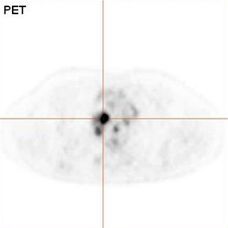Can PET Scan-Guided Therapy Work for Lymphoma?
Two studies presented at the 2014 ASH Meeting addressed whether an interim PET scan during and after an initial therapy can help guide treatment.
PET scan of a Hodgkin lymphoma

The utility of positron emission tomography (PET) scans to assess whether patients with lymphoma still have active disease and to guide further treatment remains debatable. Two studies presented at the 2014 American Society of Hematology (ASH) Annual Meeting, held December 6–9 in San Francisco, addressed whether an interim PET scan during and after initial therapy can help guide treatment.
A PET scan provides a snapshot of active metabolism and glucose uptake in the body. “Aggressive lymphomas have a markedly increased glucose uptake and metabolism,” said lead study author Ulrich Duehrsen, MD, of the department of hematology at University Hospital Essen in Essen, Germany, in his presentation. “It is assumed that a reduction in glucose uptake and metabolism during treatment reflects a decrease in the number of viable tumor cells.”
A response via a PET scan is seen as a marker for a beneficial long-term outcome. “An early reduction of the intensity of the PET signal demonstrates a rapid response to therapy,” said Duehrsen.
While pre- and post-treatment PET scans are done routinely for patients with aggressive lymphomas, the large randomized PETAL trial (NCT00554164) investigated “the value of interim PET after a few cycles of chemotherapy,” Duehrsen told Cancer Network.
Results from the trial showed that switching patients with aggressive lymphomas to a more intensive treatment regimen that included hyperfractionated alkylating agents and high doses of methotrexate and cytarabine did not yield a beneficial effect on treatment failure (complete remission rate of 50% vs 31%; P = .10) or overall survival (hazard ratio [HR], 1.0). “They are the most likely ones to benefit from novel treatment approaches, many of which were reported at the conference,” said Duehrsen.
The 926 patients with newly diagnosed disease on the trial were first treated with 2 cycles of R-CHOP (rituximab, cyclophosphamide, doxorubicin, vincristine, and prednisone). After an interim quantitative PET scan, the 107 patients (13%) with an unfavorable scan were randomized to receive either the more intensive therapy regimen or an additional 6 cycles of R-CHOP.
An interim PET scan performed after just 2 therapy cycles predicted overall survival (HR, 3.9; P < .0001).
Those patients with a rapid response to therapy, as assessed by interim PET, required less rituximab. Eight applications did not result in a better outcome as compared with six applications (HR, 1.2).
According to Duehrsen, the quantitative PET approach was much better at predicting outcomes than a visual “eye-balling” PET assessment. “With our results, we hope to convince the scientific community that accurately measuring the metabolic activity is superior to just looking at the pictures.”
Another study specifically examined outcomes among advanced diffuse large B-cell lymphoma patients who were switched to a more aggressive therapy after a positive interim PET scan following frontline therapy of 3 cycles of R-CHOP. Patients with positive interim PET scans had poorer outcomes compared with those with a negative PET scan result, and few of these patients went on to a negative PET scan following more aggressive therapy. The phase II trial was conducted in British Columbia and presented at ASH by Laurie H. Sehn, MD, MPH, of the University of British Columbia, Centre for Lymphoid Cancer, in Vancouver.
Of the 150 patients who underwent an interim PET scan, 50 (33%) were PET-positive and 48 of these received an aggressive R-ICE (rituximab, ifosfamide, carboplatin, and etoposide) chemotherapy regimen. Nine patients did not complete the full 4-cycle R-ICE regimen due to toxicity. Of the 36 patients who completed the regimen, 11 had a negative PET scan after R-ICE and 25 had a positive PET scan.
After a median follow-up of 45 months, the 4-year progression-free survival and overall survival were 59% and 73% in the positive interim PET cohort, compared with 91% and 96%, respectively, in the negative interim PET cohort.
“Simply switching to this alternate non–cross-resistant chemotherapy regimen is insufficient to overcome the inherent resistance in this poor risk population,” concluded the study authors.
Highlighting Insights From the Marginal Zone Lymphoma Workshop
Clinicians outline the significance of the MZL Workshop, where a gathering of international experts in the field discussed updates in the disease state.